Restoring saws: project 1 part 1

Well here we have the ugliest saw you’ve ever seen. See the earlier blog on car boot sale finds. This saw was covered with thick car grease and some kind of white powder. Beneath this hideous exterior lies a good Spear and Jackson from the 60’s series. These clunky looking handles marked the demise of the Spear and Jackson once revered by craftsmen throughout Britain.
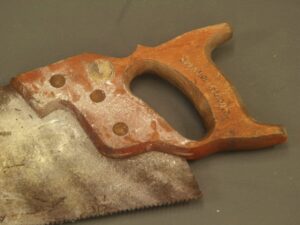
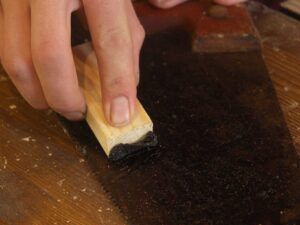
First, its best to remove the grease and any surface rust beneath it. John scraped off the excess with a wooden block and then used a finer wooden scraper to remove the rest. Notice another mark of deterioration in the use pressed fasteners instead of threaded brass screws. Imagine what half-wittedness wrought such a detrimental step in saw making.
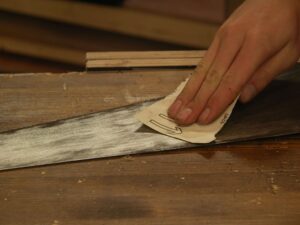
He used Norton abrasive paper to penetrate through to the steel and tackle surface rust starting with 150-grit followed by 250-grit.
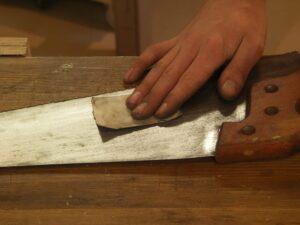
With the dirt, grease and rust removed he could tackle the reshaping of the handle. This can be achieved successfully using a 3/4″ bevel-edged chisel with the bevel facing downwards for concave edges and bevel up for convex areas. By riding the bevel of the chisel this way, John can micro-adjust the angle he presents the cutting edge to the wood according to the various curves he encounters. With a well-sharpened chisel there is no area he cannot readily tackle with relative ease.
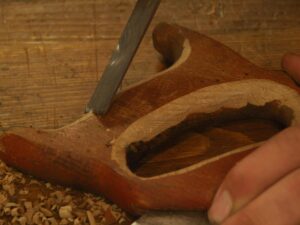
On the final stages of shaping, John relies on sandpaper and uses 150-grit to remove any hard edges and finalize the shaping before then changing to the finer 250-grit sandpaper.
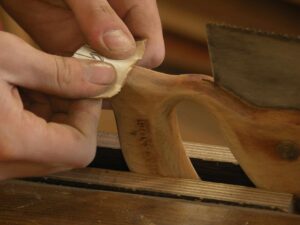
Shellac is a superb finish for sealing the grain. Ultimately the handle will be further defined and polished by John’s elbow grease and the sweat as he works with the saw over the next months and years to come.
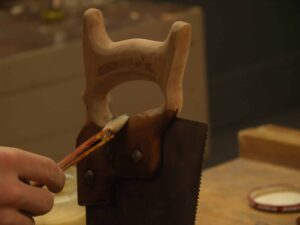
Tomorrow he will build up additional levels of the shellac coats on the saw handle and then set and sharpen the saw.
Don’t you feel inspired to go and salvage an old saw. John has now fettled a handful of saws he paid no more than
£20 for that will last him a lifetime of woodworking.


How about good old wet and dry and elbow grease. That works great, it’s cheap and it leaves a good finish though if you want to retain etching (if there is any) you must go carefully. Haven’t found anything better than wet and dry or sandpaper only followed by a light machine oil and a rag or Boshield if you can afford a can.
I have seven waiting in the basement for my undivided attention! At least one may not get much of that because it’ “plastic handled and solid teeth”; the rest, however, will get dealt with. Thanks for bringing out the techniques and also to other contributors for their trials and techniques.
I just picked up a rusty old Disston D 23 for $5.00 at a farmers market. Someone at the Somerset N.J. Show mentioned using “The Works” disinfectant toilet bowl cleaner to remove the rust. A pack of 2 bottles was $2.79 at Lowes, so I thought why not try it. I removed the handle, filled a Sterilite under-bed plastic clothes tub with both bottles, and let the saw blade marinate in the tub for about an hour. I was too excited to wait any longer.
I put on some latex gloves and started rubbing it down with a scotch brite pad. The scotch brite pad dissolved in the cleaner within a few strokes, so I switched over to 0000 steel wool.
It worked very nicely. I would recommend using a mask because it’s fairly obnoxious at full strength. Eye protection is also important here. Disposal is easy too. Pour it in the toilet (that’s what it’s for) and for extra points run the toilet bowl brush around the bowl before you flush.
2 birds, one stone.
Some of the older posts seem to have lost their accompanying images. It’s a shame as I like to plumb the archives for great, informative reports like this one on saw restoration.
Hi Paul, i am a recent arrival to Wood Working but just wanted to say ‘Yes’ , i am inspired to turn an old saw into a new one. To breathe life back into that, which was once, a proud and true time for craftsmen working with their hands. The story isn’t over yet!